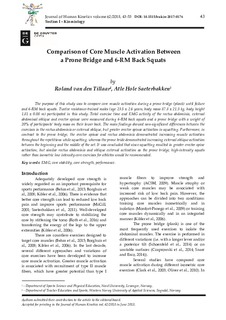Comparison of Core Muscle Activation between a Prone Bridge and 6-RM Back Squats
Journal article, Peer reviewed
Published version
Permanent lenke
http://hdl.handle.net/11250/2574205Utgivelsesdato
2018Metadata
Vis full innførselSamlinger
Originalversjon
van den Tillaar, R. & Saterbakken, A.H. (2018). Comparison of core muscle activation between a prone bridge and 6-RM back squats. Journal of Human Kinetics, 62(1), 43-53. doi: 10.1515/hukin-2017-0176Sammendrag
The purpose of this study was to compare core muscle activation during a prone bridge (plank) until failure and 6-RM back squats. Twelve resistance-trained males (age 23.5 ± 2.6 years, body mass 87.8 ± 21.3 kg, body height 1.81 ± 0.08 m) participated in this study. Total exercise time and EMG activity of the rectus abdominis, external abdominal oblique and erector spinae were measured during 6-RM back squats and a prone bridge with a weight of 20% of participants’ body mass on their lower back.
The main findings showed non-significant differences between the exercises in the rectus abdominis or external oblique, but greater erector spinae activation in squatting. Furthermore, in contrast to the prone bridge, the erector spinae and rectus abdominis demonstrated increasing muscle activation throughout the repetitions while squatting, whereas the prone bride demonstrated increasing external oblique activation between the beginning and the middle of the set.
It was concluded that since squatting resulted in greater erector spine activation, but similar rectus abdominis and oblique external activation as the prone bridge, high-intensity squats rather than isometric low intensity core exercises for athletes would be recommended.

